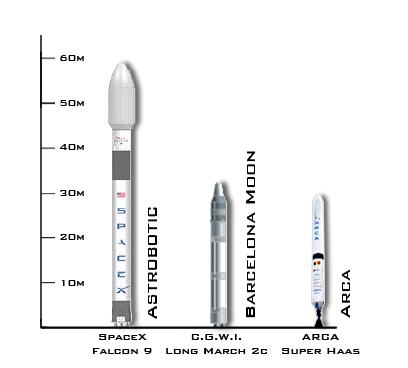 By Nathan Wong
By Nathan Wong
Part one of a five-part series about going back to the Moon, by Google Lunar X PRIZE technical consultant Nathan Wong.
"It's not the destination, it's the journey." Well, in the case of the Google Lunar X PRIZE it is both. Building systems that can operate on the Moon is a difficult task, but so is the task of getting a payload to the lunar surface safely. There have been 19 successful soft landings on the Moon, from Luna 9 on January 31, 1966 to Luna 24 on August 14, 1976, including the Apollo missions. The Apollo missions used the largest launch vehicle ever successfully launched, the Saturn V, to land its payload on the Moon. The Saturn V weighed 2.3 million kg (5 million lbs.) with a payload capacity of approximately 45,000 kg (100,000 lbs.) to lunar injection orbit. The teams competing in the Google Lunar X PRIZE won't need that large of a rocket to get their vehicle to the lunar surface, but the steps on how to get there are the similar.
We can break down the journey to the Moon into five distinct events that all need to happen successfully. Those events are the launch, trans lunar injection, lunar orbit insertion, lunar descent orbit, and landing.
Launch
This portion of the journey takes place from the surface of the Earth until outer space. One option is to build your own launch vehicle, which Team ARCA is doing with the Super Haas, but many Google Lunar X PRIZE teams will be purchasing their launch service. Currently Barcelona Moon and Astrobotic have signed launch contracts with China Great Wall Industry Corporation for a Long March 2C and SpaceX for a Falcon 9 respectively. Even launch services bought from a commercial provider are not without some risk. Industry averages for launch failures are about 7% and up to 15% for the first 10 launches of any vehicle.

Trans Lunar Injection
Once the payload has left the Earth and made it to space, the spacecraft has reduced about 95% of its prelaunch mass by burning fuel and separating stages. Odds are that the Moon is not in the exact perfect location at the time of launch for a direct transit so the spacecraft is placed into a parking orbit (temporary orbit around the Earth). As the spacecraft orbits around the Earth, the spacecraft will line up close to an energetically optimal position to fire its engines and transit towards to Moon. The transit to the moon will take approximately three days.
Lunar Orbit Insertion
Depending on the path taken from Earth orbit to the Moon, the spacecraft is either going too fast and will overshoot the Moon or is going too slow and will impact the Moon. Both of these are not ideal scenarios. To avoid this the spacecraft will fire its engines again to place itself in orbit around the Moon. Potential trouble does not end here, the lunar communication infrastructure is not as developed as that around the Earth, so there may be times when you cannot communicate with your vehicle if it is on orbit on the dark side of the Moon. The spacecraft has now traveled about 384,400 km (238,855 mi). While in this orbit you can check your potential landing site(s).
Lunar Descent Orbit
In order to reach the lunar surface the spacecraft must be put in an orbit that intersects the surface of the Moon. In order to do that, rocket engines slow down the spacecraft and it begins to drift closer and closer to the lunar surface.
Landing
Taking your spacecraft and lunar vehicle down to the surface of the Moon is probably one of the most challenging parts of the Google Lunar X PRIZE. Even if your vehicle is ready to accomplish all of the mission tasks, if you have a "hard landing" (crash) on the lunar surface you will not get a chance to show off all the hard work put into the project. In order to land safely you need to reduce your speed to zero as you come close to the lunar surface and find a safe landing spot where you can complete the mission objectives.
Conclusion
From launch to lunar landing, the teams will have minimal manual control over their spacecraft and vehicles. Most of the operations will be handled autonomously, but rest assured there is still be a lot of practice behind those maneuvers. Most of the manual control will come when the teams are physically on the Moon's surface
Hopefully this breaks down a bit how teams in the Google Lunar X PRIZE will get to the Moon. Although the transportation on the Moon gets a lot of attention, and rightfully so, I hope I could shed some light on some of the challenges and events needed to get to the Moon. The next blog post in this series will talk about some of the technical challenges that must be overcome on the Moon.
Visit X PRIZE at xprize.org, follow us on Facebook, Twitter and Google+, and get our Newsletter to stay informed.
This blog post is brought to you by Shell, our Exploration Prize Group sponsor.